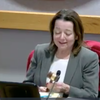Five vie for three seats on GSCD board
Enterprise file photo — Melissa Hale-Spencer
Do state tests and Common Core standards cut back on creative projects like the Guilderland Elementary School marketplace where students like Vibha Gopal, displaying a yarn doll she made, learned by doing. "It lets you know how a real business works," said Vibha. School board candidates expressed different views on the subject.
GUILDERLAND — When voters go to the polls on May 19, in addition to deciding on a $93.7 million budget, they will also choose three school board members among five candidates.
The posts are unpaid and carry three-year terms. The board has nine members.
Two incumbents — Catherine Barber and Christine Hayes — are running along with three newcomers — Timothy Burke, Nicholas Fahrenkopf, and Seema Rivera.
Jennifer Charron is not seeking a second term. Because she withdrew from the race after submitting a petition by the April 20 deadline, the district has now re-opened the window for submitting petitions, as required by state law, until Thursday, May 7, by 5 p.m..
The issues
The Enterprise asked the five candidates about their relevant experience, their reasons for running, and what they wanted to accomplish, and also asked for their views on these six topics:
— Role of a school board member: Candidates were asked who they serve. Certainly, each must balance the needs of many constituencies, but which is the primary one? Particularly if there is a crunch — for example, like now, because of economic tough times and stagnant aid coupled with a tax levy limit — would their primary allegiance be to the students, the taxpayers, the parents, the teachers, or the superintendent?
— Budget: Candidates were asked if they support the $93.7 million proposed budget, and why or why not.
They were also asked if there were specific items they would have liked included, or if there were specific items they thought should have been cut.
They were also asked their views on how much should be put in the fund balance, or rainy day account. For two years in a row, the state comptroller has reported that Guilderland is susceptible to fiscal stress, based in part on its having less than 3 percent of its budget in its fund balance; the state allows a maximum of 4 percent. This spring, with an extra $1.4 million in state aid, the district put $740,000 into savings and roughly $374,000 was added to expenses.
Finally, candidates were asked what the school board should do if the budget were voted down. If voters defeat the budget, the board can put up the same budget for a vote, put up a revised budget for a vote, or move to a contingency plan. If the budget were to be voted down again in June, the board would be required to move to a contingent budget, which would require the tax levy not be raised at all from this year.
— Tax hike: A tax-levy cap has been in place since 2012. If a school district goes over the state-set cap, 60 percent of the public vote is needed to adopt the spending plan. School districts got a break this year, both because of lower retirement contributions and added aid, but the relief may be short-lived. Guilderland had cut 227.6 posts since 2008 but added a few for next year.
Candidates were asked if programs and jobs should continue to be cut next year, if need be, to keep the tax-levy increase below the state-set cap or would constituents be willing to pay more to preserve Guilderland’s traditional curriculum?
— State tests: Standardized tests now carry more weight than ever, as the state requires that teachers be evaluated, in part, by their students’ test results. At the same time, New York State is testing students on recently adopted Common Core Learning Standards and counting the scores despite objections from New York State United Teachers, which originally agreed to testing for teacher evaluation in order for the state to receive federal Race to the Top funds.
Guilderland used an outside testing company the first year, in 2012, and then developed district tests last year. The Guilderland Teachers’ Association agreed, for this school year, to do away with the added layer of pre- and post-assessment tests that had been given to students in every elementary grade on top of the state tests.
With April’s state tests, required for students in grades 3 through 8, a statewide opt-out movement is gaining force. About 17.5 percent of Guilderland’s elementary students (438) did not take the recent English language arts exams and a little over 20 percent (478) did not take the math tests.
In light of state requirements, candidates were asked how Guilderland should proceed: Should curriculum be aligned with what is on the test? Should teachers be free to pursue creative assignments rather than teaching to the test? Do the new Common Core standards have value? Do the standardized tests have value?
—Excess space: As Guilderland enrollment continues to decline, the district hired a consultant, Paul Seversky to study the matter. In June, Seversky presented a report that concluded with six “scenarios”: One maintained the status quo and the other five proposed saving money by closing an elementary school — four would have closed Altamont Elementary and one would have shut Lynnwood. Seversky calculated this would save $1.2 million to $2 million annually.
Seversky’s report said that pupil capacity at the five elementary schools is under-used by about 14 percent; the middle school is under-used by about 25 percent; and the high school is also under-used by about 25 percent.
Months of village protests followed and, in August, the school board, in a split vote, decided to set aside Seversky’s recommendations. Rather than closing a school to solve the problem of excess space in light of declining enrollment, a task force is now looking at potential alternative uses for empty classrooms. Task force members are divided into four working groups — on pre-kindergarten, adult day care, incubator business start-ups, and commercial rentals.
Candidates were asked what course they favored and, if none of them turn out to be feasible, if a school should be closed.
— Contracts: Salaries and benefits make up the largest share of the district budget, about three-quarters of expenses. In light of the rising costs for pensions and health care with the simultaneous cuts in aid, candidates were asked if school employees whose contracts are being negotiated should get raises above their step increases or should they get any raises at all.
Updated on May 1, 2015: A sentence was added after it was announced the window for petitions was re-opened because of a candidate's withdrawal from the race.


